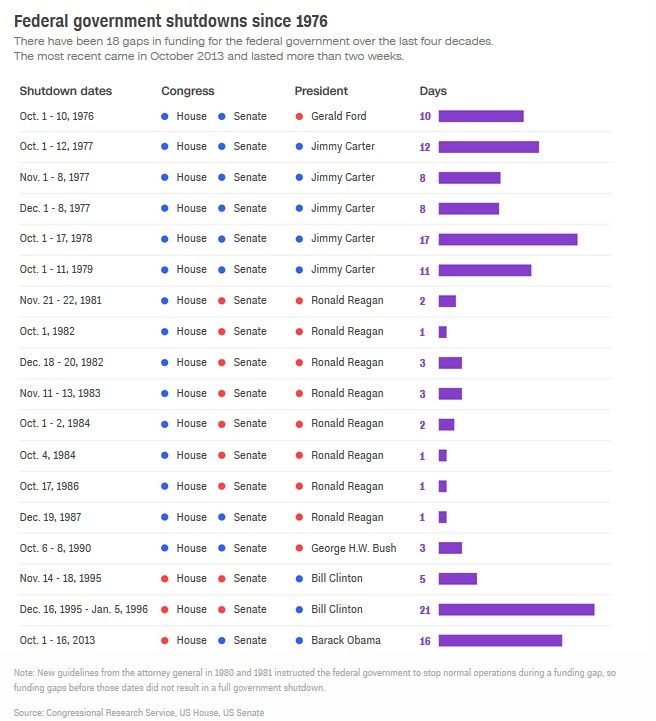Outlook:
The dollar's drop despite data that should have favored a rise is not all that peculiar—the market has already priced in the March rate hike. We can also attribute at least some of the decline to uncertainty over a budget screw-up shutting down the US government. See the list below of the other times the US government has shut down.
The real reason for the dollar drop is not US conditions, unless you count general revulsion against Trump and maybe the rise in the federal deficit, but rather other central banks seeming more hawkish, including both the ECB and the BoJ. Merkel forming a government coalition is also a boost, although it was not much of a drag in the first place.
We are inclined to think uncertainty over the US political situation is more powerful than we know, even if we can't measure it. Check this headline—"Gold hits over 4-month high as dollar index slumps to 3-year lows." It's true that gold may be recovering on divesting out of wobbly cryptocurrencies and the evidence of rising global inflation, but people buy gold because of general uncertainty, too. And nowhere do we have more uncertainty than about the US retreating from world leadership—with China replacing the US to some extent. The New Yorker had an article last week about how the country Trump is making great again is China.
Firm expectations about other central banks steeping on the gas is not all that well-founded. The ECB doesn't meet for another ten days, and if history is a guide, we will start hearing comments any day now about how a prudently gradual approach is the guidance.
And yet, while the euro seems overbought by some measures, each week the net longs keep growing.
See the COT euro position from Oanda. Widen the timeframe out to four years, and you can see the euro was in the soup for three of them (May 2014 to May 2017).
We don't like the word "cycle" because it connotes a regularity and inevitability that is not always the right way to look at a global shift, but this sure does look like a new, probably long-lasting shift.
And ECB tapering will probably have some negatives that are only dimly glimpsed now. Italy comes immediately to mind. Two of the five parties in the upcoming March election want to exit the euro. It won't be Greece but it won't be euro-friendly, either. And Stiglitz, ahead of the World Economic Fo-rum next week, told Bloomberg "The process of returning to what would be called a more normal inter-est rate I think poses some very big challenges, particularly for Europe. The market seems to assume that there won't be any problems in returning interest rates to more normal levels," but countries with high debt ratios like Italy could face "enormous strain" on budgets, he said. "And within the confines of the euro, it'll be difficult to address that."
The dollar move down is extreme and would normally be followed by an upward correction of some proportionate size. A 50% retracement of the rise off the last low would take the euro down to the red broken support line, now a kind of resistance, at about 1.2100. This is not a forecast, just a warning that it's all too easy to see a straight line continuation.
This is an excerpt from “The Rockefeller Morning Briefing,” which is far larger (about 10 pages). The Briefing has been published every day for over 25 years and represents experienced analysis and insight. The report offers deep background and is not intended to guide FX trading. Rockefeller produces other reports (in spot and futures) for trading purposes. To see the full report and the traders’ advisories, sign up for a free trial now!
This morning FX briefing is an information service, not a trading system. All trade recommendations are included in the afternoon report.
Recommended Content
Editors’ Picks
EUR/USD trades with negative bias, holds above 1.0700 as traders await US PCE Price Index

EUR/USD edges lower during the Asian session on Friday and moves away from a two-week high, around the 1.0740 area touched the previous day. Spot prices trade around the 1.0725-1.0720 region and remain at the mercy of the US Dollar price dynamics ahead of the crucial US data.
USD/JPY jumps above 156.00 on BoJ's steady policy

USD/JPY has come under intense buying pressure, surging past 156.00 after the Bank of Japan kept the key rate unchanged but tweaked its policy statement. The BoJ maintained its fiscal year 2024 and 2025 core inflation forecasts, disappointing the Japanese Yen buyers.
Gold price flatlines as traders look to US PCE Price Index for some meaningful impetus

Gold price lacks any firm intraday direction and is influenced by a combination of diverging forces. The weaker US GDP print and a rise in US inflation benefit the metal amid subdued USD demand. Hawkish Fed expectations cap the upside as traders await the release of the US PCE Price Index.
Sei Price Prediction: SEI is in the zone of interest after a 10% leap

Sei price has been in recovery mode for almost ten days now, following a fall of almost 65% beginning in mid-March. While the SEI bulls continue to show strength, the uptrend could prove premature as massive bearish sentiment hovers above the altcoin’s price.
US core PCE inflation set to signal firm price pressures as markets delay Federal Reserve rate cut bets

The core PCE Price Index, which excludes volatile food and energy prices, is seen as the more influential measure of inflation in terms of Fed positioning. The index is forecast to rise 0.3% on a monthly basis in March, matching February’s increase.


